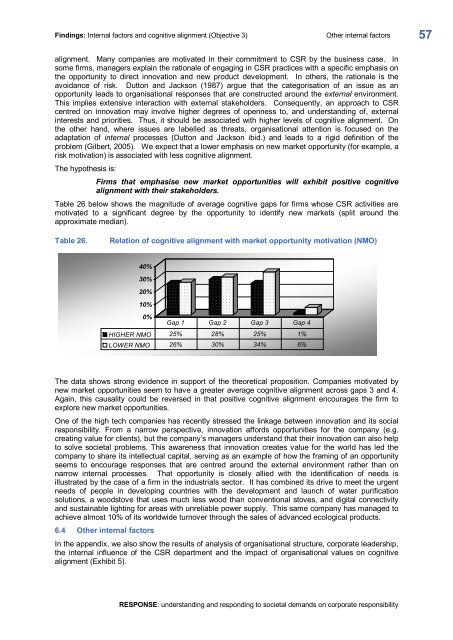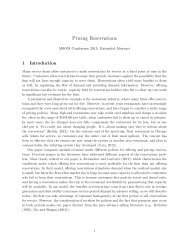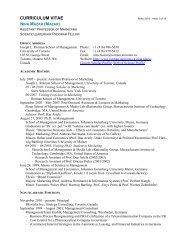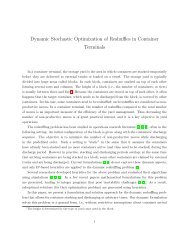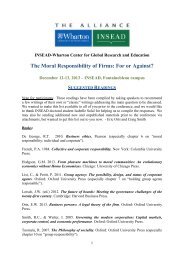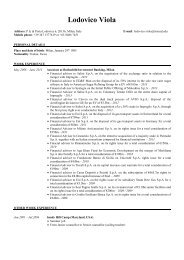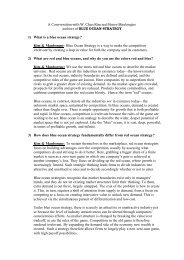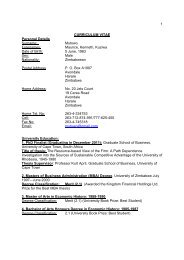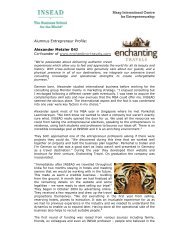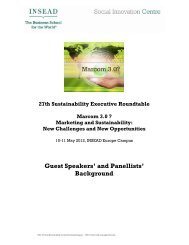RESPONSE - Insead
RESPONSE - Insead
RESPONSE - Insead
You also want an ePaper? Increase the reach of your titles
YUMPU automatically turns print PDFs into web optimized ePapers that Google loves.
Findings: Internal factors and cognitive alignment (Objective 3) Other internal factors<br />
alignment. Many companies are motivated in their commitment to CSR by the business case. In<br />
some firms, managers explain the rationale of engaging in CSR practices with a specific emphasis on<br />
the opportunity to direct innovation and new product development. In others, the rationale is the<br />
avoidance of risk. Dutton and Jackson (1987) argue that the categorisation of an issue as an<br />
opportunity leads to organisational responses that are constructed around the external environment.<br />
This implies extensive interaction with external stakeholders. Consequently, an approach to CSR<br />
centred on innovation may involve higher degrees of openness to, and understanding of, external<br />
interests and priorities. Thus, it should be associated with higher levels of cognitive alignment. On<br />
the other hand, where issues are labelled as threats, organisational attention is focused on the<br />
adaptation of internal processes (Dutton and Jackson ibid.) and leads to a rigid definition of the<br />
problem (Gilbert, 2005). We expect that a lower emphasis on new market opportunity (for example, a<br />
risk motivation) is associated with less cognitive alignment.<br />
The hypothesis is:<br />
Firms that emphasise new market opportunities will exhibit positive cognitive<br />
alignment with their stakeholders.<br />
Table 26 below shows the magnitude of average cognitive gaps for firms whose CSR activities are<br />
motivated to a significant degree by the opportunity to identify new markets (split around the<br />
approximate median).<br />
Table 26. Relation of cognitive alignment with market opportunity motivation (NMO)<br />
40%<br />
30%<br />
20%<br />
10%<br />
0%<br />
Gap 1 Gap 2 Gap 3 Gap 4<br />
HIGHER NMO 25% 28% 25% 1%<br />
LOWER NMO 26% 30% 34% 6%<br />
The data shows strong evidence in support of the theoretical proposition. Companies motivated by<br />
new market opportunities seem to have a greater average cognitive alignment across gaps 3 and 4.<br />
Again, this causality could be reversed in that positive cognitive alignment encourages the firm to<br />
explore new market opportunities.<br />
One of the high tech companies has recently stressed the linkage between innovation and its social<br />
responsibility. From a narrow perspective, innovation affords opportunities for the company (e.g.<br />
creating value for clients), but the company’s managers understand that their innovation can also help<br />
to solve societal problems. This awareness that innovation creates value for the world has led the<br />
company to share its intellectual capital, serving as an example of how the framing of an opportunity<br />
seems to encourage responses that are centred around the external environment rather than on<br />
narrow internal processes. That opportunity is closely allied with the identification of needs is<br />
illustrated by the case of a firm in the industrials sector. It has combined its drive to meet the urgent<br />
needs of people in developing countries with the development and launch of water purification<br />
solutions, a woodstove that uses much less wood than conventional stoves, and digital connectivity<br />
and sustainable lighting for areas with unreliable power supply. This same company has managed to<br />
achieve almost 10% of its worldwide turnover through the sales of advanced ecological products.<br />
6.4 Other internal factors<br />
In the appendix, we also show the results of analysis of organisational structure, corporate leadership,<br />
the internal influence of the CSR department and the impact of organisational values on cognitive<br />
alignment (Exhibit 5).<br />
<strong>RESPONSE</strong>: understanding and responding to societal demands on corporate responsibility<br />
57


